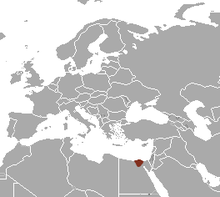Egyptian weasel
| Egyptian weasel | |
|---|---|
| Scientific classification | |
| Kingdom: | Animalia |
| Phylum: | Chordata |
| Clade: | Synapsida |
| Class: | Mammalia |
| Order: | Carnivora |
| Suborder: | Caniformia |
| Family: | Mustelidae |
| Genus: | Mustela |
| Species: | M. subpalmata |
| Binomial name | |
| Mustela subpalmata Hemprich & Ehrenberg, 1833 | |
 | |
| Egyptian weasel range | |
The Egyptian weasel (Mustela subpalmata) is a species of weasel that lives in northern Egypt. It is rated "Least Concern" by the IUCN Red List.
Description

The Egyptian weasel has short legs, a small head, and small ears. Its tail is long and thin. The weasel has a broad snout. The upper part of the body is brown and the lower part is cream-colored.[2]
Sizes for the Egyptian Weasels are:[2] -Male head-body length: 36.1–43 cm -Female head-body length: 32.6–39 cm -Male tail length: 10.9-12.9 cm -Female tail length: 9.4–11 cm -Male weight: 60-130g -Female weight: 45-60g.
The Egyptian weasel is so similar to the least weasel (Mustela nivalis) that it was only suggested to be a separate species in 1992.[3] However, a recent phylogenetic study has shown that mitochondrial DNA supports the Egyptian weasel to be a subspecies of Mustela nivalis rather than a separate species.[4]
Distribution
Northern Egypt from Alexandria east to Port Said and south through the delta and as far south as Beni Suef, 115km south of Cairo.[5]
Habitat and Life History
The Egyptian weasel lives in the same places as humans, including cities and villages and has been described as an obligate synanthrope.[1] The males of the Egyptian weasel male are solitary and highly territorial, marking the territorial boundaries with urine and faeces. The female may establish a territory within a male's territory within which she will make a nest in a cavity, wall crevice or rock pile. She defends this territory from other females. During courtship the pair trill and chatter and copulation can be quite a loud affair. After copulating she may remain with the male or the pair may separate and seek other mates. The females gives birth in her nest to a litter of between four and nine young, up to three times a year, if food supply allows.[2][5]
Diet
The Egyptian Weasel is omnivorous and includes a significant amount (~50%) of vegetables and fruit in its diet, as well as waste human food and animals including rodents, chicks of poultry, rabbits, fish and insects. Their varied and opportunistic diet reflects their opportunistic synanthropic lifestyle.[5]
References
- 1 2 McDonald, R. & Hoffmann, M. (2008). "Mustela subpalmata". IUCN Red List of Threatened Species. Version 2008. International Union for Conservation of Nature. Retrieved 21 March 2009. Database entry includes a brief justification of why this species is of least concern
- 1 2 3 "Egyptian Weasel (Mustela Subpalmata)".
- ↑ van Zyll de Jong, C.G. (1992). "A morphometric analysis of cranial variation in Holarctic weasels (Mustela nivalis)". Z. Säugetierkunde. 57: 77–93.
- ↑ Rodrigues, M.; et al. (2016). "Taxonomic status and origin of the Egyptian weasel (Mustela subpalmata) inferred from mitochondrial DNA". Genetica. 144 (2): 191–202. doi:10.1007/s10709-016-9889-y.
- 1 2 3 "Mustela subpalmata". Animal Diversity Web. Retrieved 2016-11-14.
